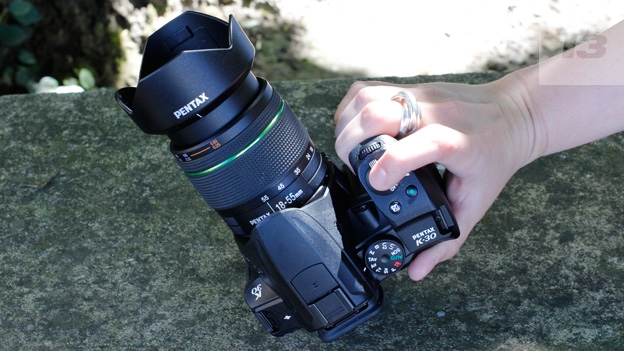Pentax K-30 review
The 16MP Pentax K-30 is the brand's latest entry-level DSLR for outdoorsy types

-
+
Weatherproof sealing
-
+
Detail-rich images
-
+
Fun digital filters
-
-
No custom menu
-
-
Can’t use filters in raw mode
-
-
Noisy
-
-
slow AF with kit lens
Why you can trust T3











With 81 seals, the 16MP Pentax K-30 is a fully weather- and dust-proofed SLR with automatic modes for novices as well as advanced shooting options
As it replaces the K-r, the Pentax K-30 joins the Pentax K-5 in the brand's two-camera SLR line-up as the entry-level model. Consequently it is thrown into the fray to compete with the likes of the Canon EOS 1100D, Canon 600D and the new touchy-feely Canon 650D as well as the 24MP Nikon D3200.
Unlike these cameras the K-30 is fully weatherproofed so, provided it's couple with one of Pentax's WR lenses, it can be used even when it's raining. Dust and sand don't bother it either.
Another unusual feature for a camera at this level is that the viewfinder shows 100% of the scene, so you shouldn't be surprised by any stray objects around the edges of the frame when you review images.
Perhaps the most unusual aspect of the Pentax K-30, however, is that the Shake Reduction system that moves the sensor to reduce the impact of camera shake, can be used to correct sloping horizons by up to 1 degree and to adjust the composition by shifting the sensor by up to 1mm in 16 steps.
More useful, perhaps though is the electronic level that can be displayed on the LCD or in the viewfinder to help keep horizon's level.
Pentax K-30: Controls
Although it's not smothered in buttons and dials, the K-30 has direct access to all the essential features such as sensitivity (ISO), drive mode, white balance and the flash options via the navigation controls on the back of the camera.
Though these buttons are replicated on the screen, this is purely for guidance as the screen isn't touch-sensitive. These shortcut/navigation buttons are also used for selecting the AF point when the appropriate mode is activated.
On these occasions pressing the OK for a couple of seconds toggles between allowing the user to set the AF point and access the sensitivity settings etc. Once you are used to it, it's a very quick and easy approach.
Pressing the Info button can bring up an information screen that displays 15 key camera settings. Any of the settings can be changed by navigating to the desired point and then scrolling through the options using the rear control dial. It's very quick and easy to use.
Pentax K-30: Screen
Though it can't quite match the 1,040,000-dot resolution of the screens on the Canon 600D and 650D, with 921,000 dots, the 3 -inch screen on the K-30 is very good for an entry-level camera. There are a few reflections in very bright light, but on the whole we found it provides a nice clear view with crisp details.
It's a shame the menu looks so dated and doesn't have a custom menu screen to which users can assign their most frequently used menu options though.
Pentax K-30: Battery
Pentax supplies a rechargeable lithium-ion battery with the K-30, but the battery compartment is designed so that it can accept either this or four AA batteries. This is useful for travelers who are unable to get access to mains power to charge the battery, but can find AA batteries.
When the flash is used for 50% of images the Li-ion battery is stated to last for 410 images, shooting completely without flash boosts this to 480 images.
Pentax K-30: Picture quality
The K-30 captures an impressive amount of detail and in the Natural Custom Image setting colours look - natural. If needs must the sensitivity range can be expanded to ISO 25,600, but we suggest that this is kept for emergencies only.
We'd also avoid using the top native sensitivity setting of ISO 12,800 if you can, as the images have lots of colour noise. The results at ISO 3200 and below, however, are very good.
Though it can be prone to underexposing in the face of bright areas, the K-30's 77-segment metering system isn't quite as troubled by this as some of Pentax's earlier DSLRs.
With the 18-55mm f/3.5-5.6 DA WR kit lens mounted the AF system can be quite hesitant in anything less than perfect light. But when a lens such as the DA 18-135mm f/3.5-5.6 ED AL [IF] DC WR that has an internal focusing motor is used the focusing becomes much quicker, more decisive and significantly quieter.
Pentax K-30: Verdict
We're pretty impressed with the Pentax K-30. It allows you take high quality 16MP images in the type of conditions that would result in other cameras needing a trip to the service centre. The control layout is sensible and all the important features can be assessed quickly.
There's also plenty of opportunity to tailor images to your own taste and raw files are saved in the popular DNG format. It's a shame that you can't use the Digital Filters when you shoot in that format though If you set the maximum automatic sensitivity setting to ISO 3200, you can shoot with confidence that you will capture images that have lots of detail with well-controlled noise.
Pentax K-30 availability: Available now
Pentax K-30 price: £679 (with 18-55mm kit lens), US price $849.95 (body only) $1,199.95 (with 18-55mm kit lens)
Sign up to the T3 newsletter for smarter living straight to your inbox
Get all the latest news, reviews, deals and buying guides on gorgeous tech, home and active products from the T3 experts
Angela has been Amateur Photographer magazine’s Technical Editor and Head of Testing for Future’s photography portfolio. She’s a widely respected editor, writer and reviewer as well as a CAA-qualified drone pilot.
-
 Always on the move? This smart backpack makes travelling light a complete breeze
Always on the move? This smart backpack makes travelling light a complete breezeSay hello to the Mous Optimal Travel Backpack...
By Lizzie Wilmot Published
-
 I'm late to one of Netflix's best sci-fi shows – and now eager for season 2
I'm late to one of Netflix's best sci-fi shows – and now eager for season 23 Body Problem is brain-bending sci-fi wonderment – and I want more already
By Mike Lowe Published
-
 Netflix's new show proves it wants a slice of The Pitt's pie
Netflix's new show proves it wants a slice of The Pitt's piePulse looks very familiar
By Max Freeman-Mills Published